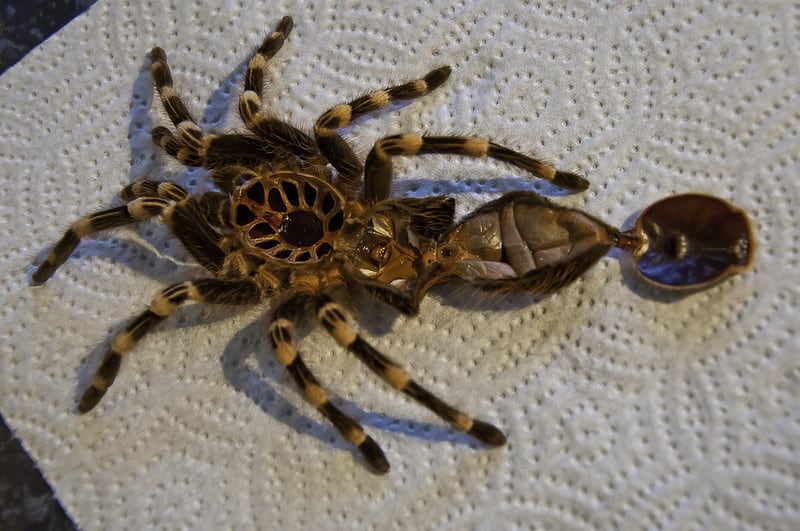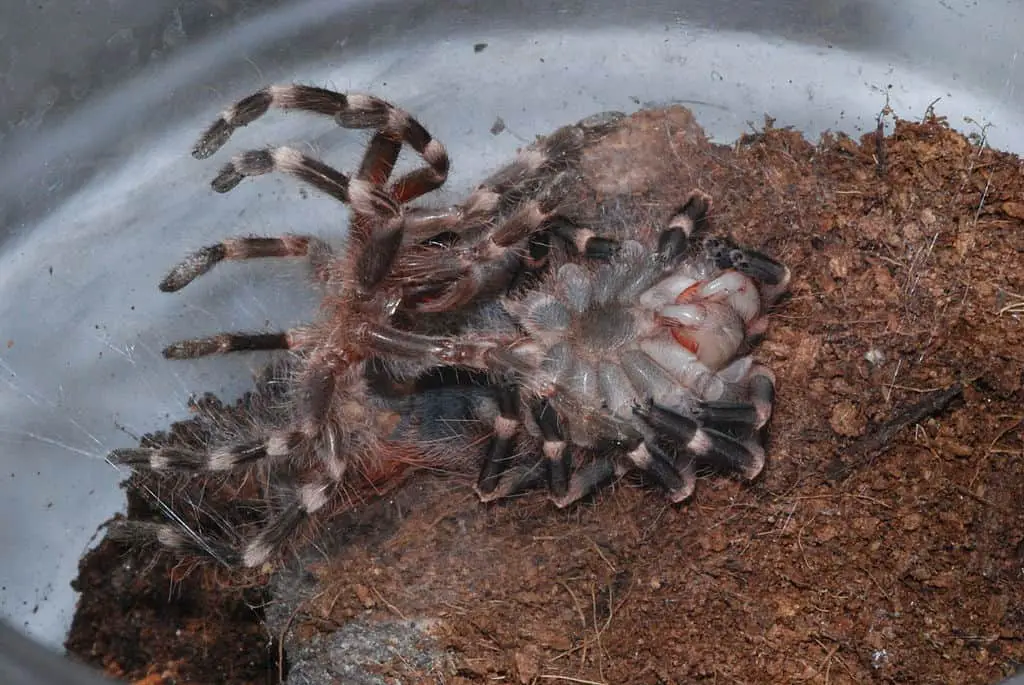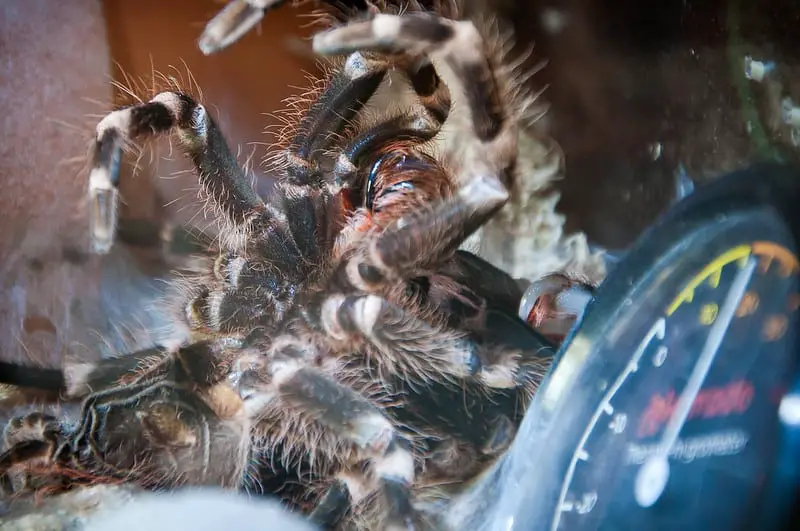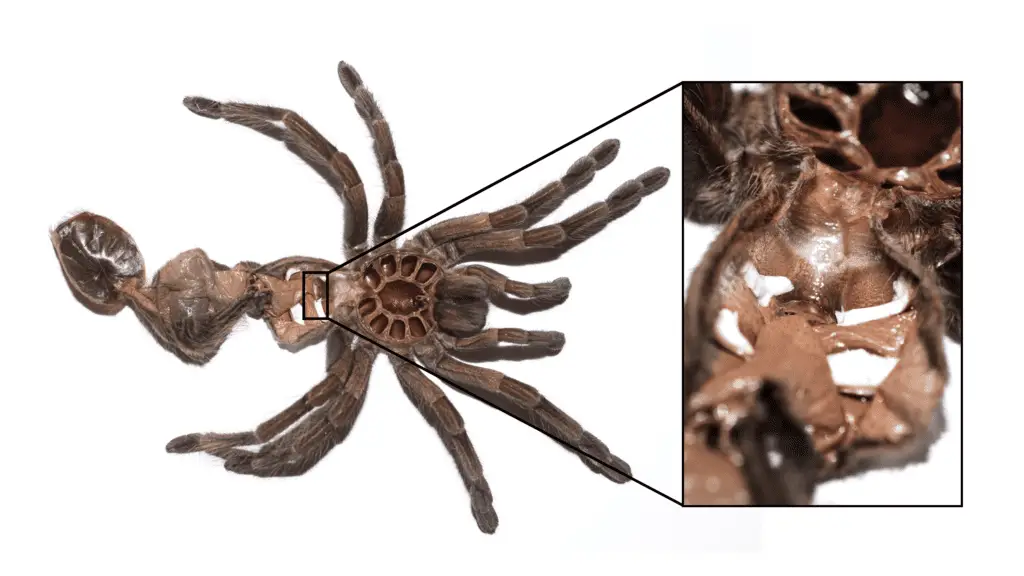Every spider molts and tarantulas are no exception. However, when you’re new to owning these arachnids, this whole process might be a bit confusing. Since they often molt while laying on their back, it’s very common for inexperienced owners to be worried that their tarantula is dying or that there is something wrong, while in reality, they’re just shedding their exoskeleton to make way for a larger one.
It’s very normal to be full of questions about this interesting process, but worry not, I’m here to help. In this guide, I’m going to go over everything you need to know about this unusual behavior.
I will go over questions such as why they molt, how often they do it, and many more. Let’s get started, shall we?

What is molting?
Molting is the process of shedding the old exoskeleton so that a new one can take its place. All tarantulas do this, but not all of them molt equally as often. Some species go through it more often than others.
In addition, females typically shed their exoskeleton more times in their life than males. The reason for this is that females grow to a larger size.
Why do tarantulas molt?

Tarantulas molt because they need to replace their old exoskeleton with a bigger one. The reason for this is that their exoskeleton is solid and can not grow. Also, it can not really be stretched.
Therefore, since the spider is increasing in size, but the exoskeleton is not, the only way they can keep growing is by shedding their exoskeleton to make way for a bigger one.
How often do tarantulas molt?
How often tarantulas molt depends on the species, their gender, and their age. Baby tarantulas will experience this much more often than older ones.
The reason why young tarantulas have to shed their skeleton so much more often is because they grow much faster. Since they grow so much faster they need to molt more often so that the exoskeleton can keep up with their fast growth rate.
In addition, adult females go through the entire process much more often than males. Adult males molt very rarely and sometimes completely stop altogether.
Since there are so many factors that influence how often it happens there is no clear-cut answer to the questions at hand. It all depends on what species of tarantula you have, their sex, and how old they are.
Generally speaking though, a young tarantula will molt up to once a month, while an older tarantula will molt between every six months and every two years.
The molting process

Let’s take an in-depth look at how the molting process usually goes for a tarantula. There are 3 stages that they undergo.
1. Pre-molt
There are 4 major signs that you can use to identify when your tarantula is going to molt soon.
The stage before they molt is called “premolt” and you can tell that they’re in this stage by keeping an eye out for the following signs:
- Lower activity levels. Most tarantulas are already not very active and spend a lot of their day hiding away in their burrow. However, when the time to molt comes, they will be even less active than usual. You might notice that your T will move more slowly and is generally quite sluggish.
- Dull colors. One of the most telling signs that your spider is about to molt is when its coloration becomes less bright. The reason for this is that their old exoskeleton is about to be shed and thus loses some of its colorations.
- Lower appetite. Tarantulas will stop eating before they’re about to molt. Sometimes, they stop eating completely weeks before they’ll actually molt. They stop eating because they need to decrease their body volume to be able to get out of their old exoskeleton more easily.
- Bald spot. You might also notice that your tarantula develops a bald spot before molting. This bald spot does not always appear, but when it does, you can find it on their abdomen.
2. The Molt
Once your tarantula starts molting you will notice that they will lay on their back or on their side. Don’t worry, this is completely normal, they’re not dying. If they’re dying they will usually not lay on their back but will rather curl up their legs.
When they are molting it is crucial that you leave them alone and do not disturb them. The molting process is very energy-intensive and stressful so doing whatever you can to make the process as easy for them as possible is very important.
If you start touching them while they are molting they will become even more stressed out and may actually fail to properly molt.
The molting process can take anywhere from 15 minutes to several hours. Usually, the bigger the spider, the longer it takes to molt. Be patient, try not to help them. They’re perfectly capable of doing this all on their own.
3. After the molt
Once your tarantula has successfully shed its old exoskeleton and has completed its molt they are very vulnerable. Their new exoskeleton is very fragile and they should not be touched for at least a week after they’ve molted.
In addition, you should wait several days before you start feeding them. The prey animals you give your spider can harm them if you offer them before their new exoskeleton has fully hardened. In addition, they need time for their fangs to harden before they’re capable of taking on prey.
Don’t worry about your spider starving, they can go for extremely long periods without food due to their low metabolism so there’s no danger in waiting a few days before feeding them. Some tarantulas can go without food for up to 2 years so a couple of days is nothing for them. As long as they have access to water, they will be totally fine.
Molting troubles
Usually, tarantulas can shed their exoskeleton just fine and there are no problems. Nevertheless, problems can occur so it’s good to be prepared.
The most common problem is that your T is unable to escape from its old carapace.
This usually occurs when the humidity levels are not high enough and there is not enough moisture.
To prevent this, make sure that you keep the moisture at high enough levels in their enclosure.
Helping your tarantula molt
If you notice that your eight-legged friend is obviously struggling to escape their old carapace you can try to help them by gentling moisturizing the area where it’s having trouble with a moist brush.
This increase in moisture will make it easier for the spider to escape from their carapace.
Do tarantulas eat their molt?
There have been reports of tarantulas eating the old exoskeleton that they’ve just shed. Usually, they only eat the stomach and book lungs.
Generally speaking, they do not eat their molt because there is no nutritional value in the exoskeleton they just shed. They usually drag the shed exoskeleton away from their hide and continue on with their day. This is instinctive behavior to avoid notifying predators and prey that their burrow is nearby.
Since they generally do not eat their old exoskeleton it’s fine to remove it from their enclosure once they’re done molting.
If you have a New-World species, make sure to use a pair of tweezers to do this. New-World species have hairs on their exoskeleton called urticating hairs.
These are usually used as a defense mechanism, but if you pick up the molt with your hands, the hairs can get stuck on your hands.
If you then rub your eyes the urticating hairs can get in your eyes which can do serious damage and can even cause blindness so be careful.
Using the old exoskeleton to determine if you have a male or female

Before you throw the molt away, you might want to use it to identify whether you have a male or female specimen.
Many spiders are sold as unsexed slings and the difference can be hard to tell, so using a molt is a great way to figure out if you have a male or a female.
To do this, look for the spermathecae. It’s hard to describe how to find it, so if you’d like to find out whether you have a male or a female using the old exoskeleton, check out this video
Is my tarantula dead or molting?
One thing that many hobbyists ask themselves is whether their tarantula is dead or molting. This is a common question because tarantulas often lay on their back in order to shed their old skin, which can make it seem like they’ve passed away.
Luckily, if you know what to look for you can easily tell the difference between your tarantula molting and dying.
Dead or dying tarantulas usually do not lay on their back or on the floor with their legs spread out. Instead, they curl their legs under them in what’s called a death curl. Molting tarantulas, on the other hand, often lay on their back.
Is molting painful for tarantulas?
Unfortunately, there’s no way to really know if molting is painful for tarantulas. We can’t talk to them, and studying whether or not they feel pain during the molting process would be extremely difficult.
However, one thing we do know is that their skin is very sensitive after they’ve molted so make sure to keep that in mind otherwise you can easily hurt your spider.
What does molting look like?
I’ve you’ve never seen your tarantula molt and can’t wait until they do to find out what it looks like, check out this cool gif of a time-lapse of a tarantula shedding its old skin.
It’s very interesting and will give you a good idea of what to expect. Here’s also a video that you can check out:
Final words
Molting is normal behavior for tarantulas and something that they will do many times throughout their lives. Especially when they’re young and growing fast, they need to shed their exoskeleton in order to keep growing.
The first time you see this as someone who’s new to the hobby you might be a bit confused, but you’ll get used to it in no time. It’s beautiful to witness and is one of the coolest aspects of tarantula ownership.
- How Long Do American Eskimo Dogs Live? Important Factors and Care Tips - September 29, 2023
- Do American Bulldogs Need Grooming? Essential Tips and Care Guidelines - September 29, 2023
- Do Bengal Cats Enjoy Playing? Essential Tips for Keeping Them Active - September 29, 2023